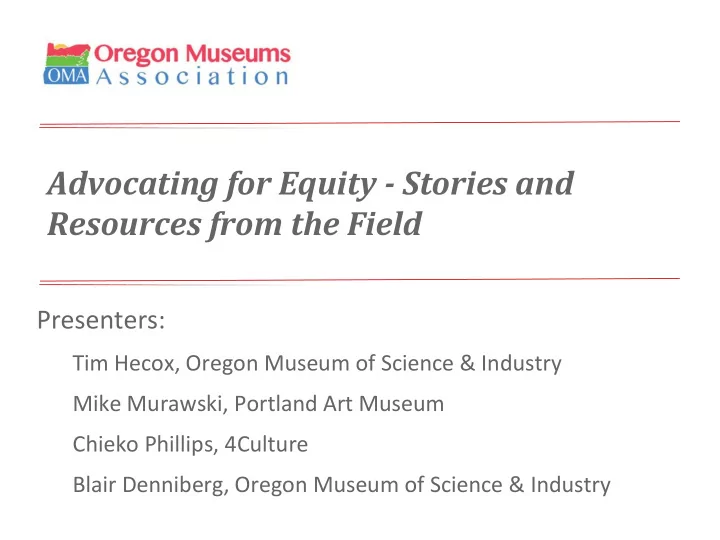

Advocating for Equity - Stories and Resources from the Field Presenters: Tim Hecox, Oregon Museum of Science & Industry Mike Murawski, Portland Art Museum Chieko Phillips, 4Culture Blair Denniberg, Oregon Museum of Science & Industry
“If your museum is large or small, old or young, famous or not yet famous, the need for seeking and sustaining diversity in your museums…has never been greater. If we are to be relevant in this ever-changing world, to stay artistically and financially viable, all of our museums must boldly— indeed, bodaciously—commit to rethinking about what takes place in our museums, to whom our museums belong and who the colleagues are who have the privilege of telling important stories through the power of science, history, culture and art.” — Dr. Johnnetta Betsch Cole
Chieko chieko.phillips@4culture.org
MASS ACTION MUSEUM AS SITE FOR SOCIAL ACTION est. 2016 What is the role and responsibility of the museum in responding to issues affecting our communities locally and globally? How do the museum’s internal practices need to change in order to align with, and better inform, their public practice? How can the museum be used as a site for social action?
MASS ACTION MUSEUM AS SITE FOR SOCIAL ACTION est. 2016 More information: https://www.museumaction.org/ Download Toolkit: https://www.museumaction.org/resources/
Pressing issues facing our organizations Page 11
8 Key Findings
Project Goals • Gather information about the current operations, potential opportunities , and pressing needs of heritage organizations throughout King County. • Provide individuals, institutions, and umbrella organizations actionable information for current activities and future planning . • Equip 4Culture Heritage staff with a “synopsis” of the state of heritage, to aid in the shaping of ongoing, and future, grant and technical assistance programs .
Who did we hear from? Organizations in every council district, the most from 4,8,2. Lower response rates from 6, 7, 9. n=72 Page 7 & 15
Modest organizational budgets Page 18
Shared Vocabulary and a set of Basic Principles This document presents a shared vocabulary and a set of basic principles to guide museum professionals toward incorporating DEAI into the heart of our work. It is meant to be a starting place, not an endpoint. Findings are presented as food for thought to jump-start the long-term processes that effective DEAI work requires.
Five Insights and a Call to Action The working group’s learnings can be summed up into five insights about the key components of effective museum DEAI work. 1. Every museum professional must do personal work to face their unconscious bias 2. Debate on definitions must not hinder progress 3. Inclusion is central to the effectiveness and sustainability of museums 4. Systemic change is vital to long-term, genuine progress 5. Empowered, inclusive leadership is essential at all levels of an organization
Shout outs to: Annette Gavigan, California Academy of Sciences Renae Youngs, Minnesota State Arts Board Christopher Leitch, Independent Museum Professional Barbara Cohen- Stratyner, Independent Museum Professional Michael Lesperance, The Design Minds Michael Berlucchi, Chrysler Museum of Art W. James Burns, Arizona Historical Society
What are the Welcoming Guidelines? ● A tangible tool that members of the museum community could consult ● Inspired by a 2013 AAM session recognizing the need for consensus on LGBTQ awareness and issues in museums ● It encourages museum practices to match legal, societal recognition of LGBTQ communities ● Help museums improve service to visitors, support staff and volunteers, and increase stakeholder buy in
About Welcoming Guidelines Within the AAM’s Characteristics of Functional areas to align AAM’s Excellence, 38 standards are Standards to better reflect the grouped into 7 categories: broad need for LGBTQ friendly polocies nad and procedures: ● Public Trust and Accountability ● Curatorial ● Mission and Planning ● Public Engagement ● Leadership and Organizational ● Guest Experience Structure ● Visitor Research and ● Collections Stewardship Evaluation ● Education and Interpretation ● Human Resources ● Financial Stability ● Communication/ Development ● Facilities and Risk Management
Summary ● Is your museum a welcoming place? ● What about your own practice? ● Beyond LGBTQ Inclusion ○ How the Welcoming Guidelines can be adapted to focus on other underrepresented communities ● What’s next?
“Diversity work does not simply generate knowledge about institutions... it generates knowledge of institutions in the process of attempting to transform them.” — Sara Ahmed, feminist scholar and anti ‑ harassment advocate Thank you for all that you do!
Recommend
More recommend